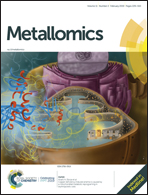Thimerosal inhibits Drosophila melanogaster tyrosine hydroxylase (DmTyrH) leading to changes in dopamine levels and impaired motor behavior: implications for neurotoxicity†
Abstract
Thimerosal (THIM) is a well-established antifungal and antiseptic agent widely used as a preservative in vaccines. Recent studies identified the neurotoxic effects of THIM, including malfunction of the monoaminergic system. However, the underlying cytotoxic mechanisms are not well understood. Here we used the fruit fly Drosophila melanogaster to investigate the mechanisms of THIM-induced neurotoxicity. We focused on the dopaminergic system, and the rate-limiting enzyme tyrosine hydroxylase (DmTyrH), to test the hypothesis that THIM can impair dopamine (DA) homeostasis and subsequently cause dysfunction. We studied the effect of THIM by feeding 1–2 day old flies (both sexes) food supplemented with 25 μM THIM for 4 days and determined THIM-induced effects on survival, oxidative stress, and metabolic activity based on MTT assay and acetylcholinesterase (AChE) activity. Our results demonstrate that D. melanogaster exposed to THIM present changes in DmTyrH expression and activity, together with altered DA levels that led to impaired motor behavior. These phenotypes were accompanied by an increase in oxidative stress, with a decrease in MTT reduction, in AChE activity, and also in survival rate. These findings suggest an initiating and primary role for THIM-mediated DmTyrH dysfunction that leads to impaired DA function and behavioral abnormalities, ultimately causing oxidative stress-related neurotoxicity.



 Please wait while we load your content...
Please wait while we load your content...